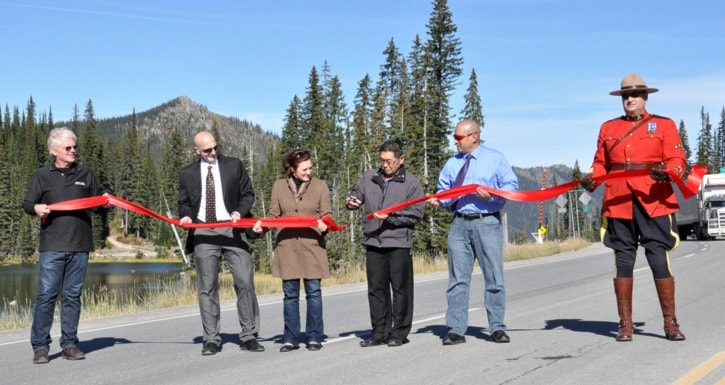About 300 people attended the 50th anniversary celebration for the Kootenay Pass, held on Sunday afternoon at the top of the Highway 3 pass between Creston and Salmo.
Organized by the Creston Museum, with the assistance of the Ministry of Transportation and Infrastructure and Yellowhead Road and Bridge (YRB), the event included historical displays and a commemorative ribbon-cutting, which briefly stopped traffic.
“We find excuses to make local history fun and enjoyable,” said museum manager Tammy Hardwick.
Cars lined up for the first crossing on Oct. 13, 1963, totalled 2,700 — the creation of the all-weather route was a significant event.
“That really shows what it meant to them back then,” said Hardwick. “This was a good opportunity to showcase that.”
During speeches by elected officials and others, Lower Kootenay Band Chief Jason Louie explained that the Ktunaxa people followed game trails along that route hundreds of years earlier.
“We are also in their home,” he said. “If it was not for those animals, we would not have access to this territory.”
Nelson-Creston MLA Michelle Mungall followed Louie, expressing her appreciation for the economic benefits, and also reflected on the wildlife.
“The most magical trip has been the time I have to stop and allow the caribou to take the time to cross the road,” she said.
Regional District of Central Kootenay Area C director Larry Binks, who represents the east side of the pass, said that the route marked a big change for both health care and agriculture, with improved access for both.
“What a wonderful testament to the people who went before, and the men and women who worked on it!” said Binks, who then thanked contractor YRB for keeping it going, earning a round of applause.
RDCK Area G director Hans Cunningham recalled that people used to head up the pass for a Sunday drive to check out the scenery, and said he is still impressed with the road.
“The highway is only getting better,” he said. “We’re very lucky to have this all-weather road.”
Ministry of Transportation and Infrastructure district operations manager Hugh Eberle explained that the construction allowed the elimination of tolls on the Kootenay Lake ferries and Nelson’s Big Orange Bridge, also reducing travel time between the east and west.
The project, which had been in the planning stages for several years before seasonal construction ran from 1957-1963, cost $13.6 million, and it remains the country’s highest year-round mountain pass.
“It proved that highway engineering can actually work miracles,” he said.
